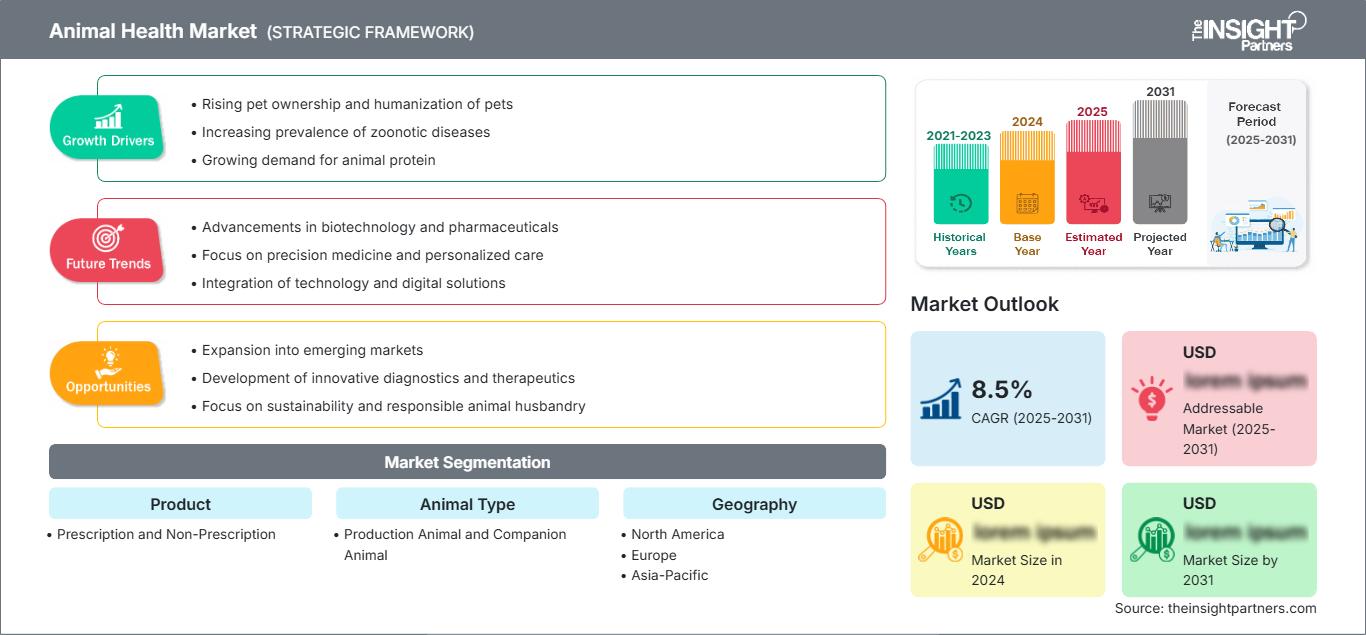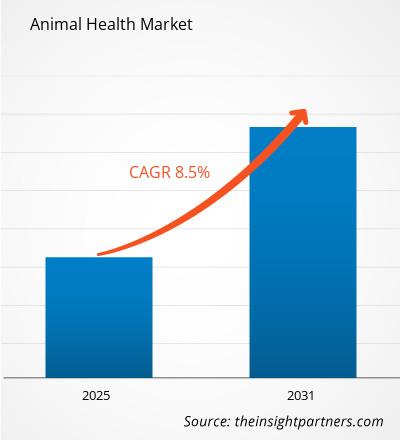Si prevede che il mercato della salute animale raggiungerà i 144,15 miliardi di dollari entro il 2031. Si prevede che il mercato registrerà un CAGR del 6,8% nel periodo 2025-2031.
Il rapporto è suddiviso in due sezioni: Prodotto (con e senza prescrizione medica) e Tipo di animale (Animale da produzione e Animale da compagnia). L'analisi globale è suddivisa a livello regionale e per i principali Paesi. La valutazione del mercato è presentata in dollari USA per l'analisi segmentale di cui sopra.
Scopo del rapporto
Il rapporto "Animal Health Market" di The Insight Partners mira a descrivere il panorama attuale e la crescita futura, i principali fattori trainanti, le sfide e le opportunità. Ciò fornirà spunti a vari stakeholder aziendali, come:
- Fornitori/produttori di tecnologia: per comprendere le dinamiche di mercato in evoluzione e conoscere le potenziali opportunità di crescita, consentendo loro di prendere decisioni strategiche informate.
- Investitori: per condurre un'analisi completa delle tendenze in merito al tasso di crescita del mercato, alle proiezioni finanziarie del mercato e alle opportunità esistenti lungo la catena del valore.
- Organismi di regolamentazione: per regolamentare le politiche e le attività di polizia nel mercato con l'obiettivo di ridurre al minimo gli abusi, preservare la fiducia degli investitori e sostenere l'integrità e la stabilità del mercato.
Segmentazione del mercato della salute animale Prodotto
- Su prescrizione medica e senza prescrizione medica
Tipo di animale
- Animale da produzione e animale da compagnia
Potrai personalizzare gratuitamente qualsiasi rapporto, comprese parti di questo rapporto, o analisi a livello di paese, pacchetto dati Excel, oltre a usufruire di grandi offerte e sconti per start-up e università
Mercato della salute animale: Approfondimenti strategici

-
Ottieni le principali tendenze chiave del mercato di questo rapporto.Questo campione GRATUITO includerà l'analisi dei dati, che vanno dalle tendenze di mercato alle stime e alle previsioni.
Fattori di crescita del mercato della salute animale
- Aumento del numero di animali domestici e umanizzazione degli stessi: sempre più persone adottano animali domestici, li trattano come membri della famiglia e investono nella loro assistenza sanitaria.
- Crescente prevalenza di malattie zoonotiche: le malattie che possono diffondersi tra animali ed esseri umani sono in aumento, aumentando la necessità di misure di salute animale.
- Crescente domanda di proteine animali: la popolazione mondiale è in aumento, con conseguente maggiore domanda di carne e latticini, che aumenta la necessità di bestiame sano.
Tendenze future del mercato della salute animale
- Progressi nella biotecnologia e nella farmaceutica: le nuove tecnologie stanno portando a vaccini, diagnosi e trattamenti più efficaci per le malattie animali.
- Concentrarsi sulla medicina di precisione e sulle cure personalizzate: personalizzare i trattamenti per i singoli animali in base alle loro esigenze specifiche e al loro corredo genetico.
- Integrazione di tecnologia e soluzioni digitali: utilizzo della tecnologia per attività quali monitoraggio remoto, telemedicina e analisi dei dati per migliorare la cura degli animali.
Opportunità di mercato per la salute animale
- Espansione nei mercati emergenti: molti paesi in via di sviluppo hanno popolazioni animali in crescita e una domanda crescente di prodotti e servizi per la salute animale.
- Sviluppo di soluzioni diagnostiche e terapeutiche innovative: creazione di strumenti nuovi e migliorati per la diagnosi e il trattamento delle malattie animali.
- Concentrazione sulla sostenibilità e sull'allevamento responsabile: promozione del benessere degli animali, riduzione dell'impatto ambientale dell'agricoltura animale e garanzia di un uso responsabile degli antibiotici.
Le tendenze regionali e i fattori che influenzano il mercato della salute animale durante il periodo di previsione sono stati ampiamente spiegati dagli analisti di The Insight Partners. Questa sezione illustra anche i segmenti di mercato e la geografia della gestione delle malattie del ritmo cardiaco in Nord America, Europa, Asia-Pacifico, Medio Oriente e Africa, America meridionale e centrale.
Ambito del rapporto sul mercato della salute animale
| Attributo del rapporto | Dettagli |
|---|---|
| Dimensioni del mercato in 2024 | US$ XX Billion |
| Dimensioni del mercato per 2031 | US$ 144.15 Billion |
| CAGR globale (2025 - 2031) | 6.8% |
| Dati storici | 2021-2023 |
| Periodo di previsione | 2025-2031 |
| Segmenti coperti |
By Prodotto
|
| Regioni e paesi coperti |
Nord America
|
| Leader di mercato e profili aziendali chiave |
|
Densità degli operatori del mercato della salute animale: comprendere il suo impatto sulle dinamiche aziendali
Il mercato della salute animale è in rapida crescita, trainato dalla crescente domanda degli utenti finali dovuta a fattori quali l'evoluzione delle preferenze dei consumatori, i progressi tecnologici e una maggiore consapevolezza dei benefici dei prodotti. Con l'aumento della domanda, le aziende stanno ampliando la propria offerta, innovando per soddisfare le esigenze dei consumatori e sfruttando le tendenze emergenti, alimentando ulteriormente la crescita del mercato.

- Ottieni il Mercato della salute animale Panoramica dei principali attori chiave
Punti di forza
- Copertura completa: il rapporto analizza in modo esaustivo prodotti, servizi, tipologie e utenti finali del mercato della salute animale, fornendo un panorama olistico.
- Analisi di esperti: il rapporto è redatto sulla base della conoscenza approfondita di esperti e analisti del settore.
- Informazioni aggiornate: il rapporto garantisce la pertinenza aziendale grazie alla copertura di informazioni e tendenze dei dati recenti.
- Opzioni di personalizzazione: questo rapporto può essere personalizzato per soddisfare le esigenze specifiche del cliente e adattarsi in modo appropriato alle strategie aziendali.
Il rapporto di ricerca sul mercato della salute animale può quindi contribuire a guidare il percorso di decodificazione e comprensione dello scenario del settore e delle prospettive di crescita. Sebbene possano esserci alcune valide preoccupazioni, i vantaggi complessivi di questo rapporto tendono a superare gli svantaggi.
- Analisi storica (2 anni), anno base, previsione (7 anni) con CAGR
- Analisi PEST e SWOT
- Valore/volume delle dimensioni del mercato - Globale, Regionale, Nazionale
- Industria e panorama competitivo
- Set di dati Excel
Report recenti
Rapporti correlati
Testimonianze
Motivo dell'acquisto
- Processo decisionale informato
- Comprensione delle dinamiche di mercato
- Analisi competitiva
- Analisi dei clienti
- Previsioni di mercato
- Mitigazione del rischio
- Pianificazione strategica
- Giustificazione degli investimenti
- Identificazione dei mercati emergenti
- Miglioramento delle strategie di marketing
- Aumento dell'efficienza operativa
- Allineamento alle tendenze normative






















 Ottieni un campione gratuito per - Mercato della salute animale
Ottieni un campione gratuito per - Mercato della salute animale